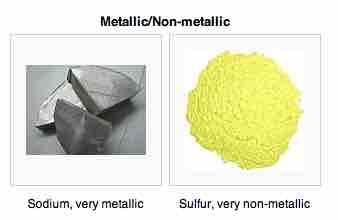In chemistry, a group is a vertical column in the periodic table of the chemical elements. There are 18 groups in the standard periodic table, including the d-block elements but excluding the f-block elements. Each element within a group has similar physical or chemical properties because of its atom's outermost electron shell (most chemical properties are dominated by the orbital location of the outermost electron).
Common Physical Properties
A physical property of a pure substance can be defined as anything that can be observed without the identity of the substance changing. The observations usually consist of some type of numerical measurement, although sometimes there is a more qualitative (non-numerical) description of the property. Physical properties include such things as:
- Color
- Brittleness
- Malleability
- Ductility
- Electrical conductivity
- Density
- Magnetism
- Hardness
- Atomic number
- Specific heat
- Heat of vaporization
- Heat of fusion
- Crystalline configuration
- Melting temperature
- Boiling temperature
- Heat conductivity
- Vapor pressure
- Tendency to dissolve in various liquids
These are only a few of the measurable physical properties.
Within a group of the periodic table, each element has the same valence electron configuration. For example, lithium, sodium, potassium, rubidium, cesium, and francium all have a single electron in an s orbital, whereas every element in the group including fluorine has the valence electron configuration ns2np5, where n is the period. This means the elements of a group often exhibit similar chemical reactivity, and there may be similarities in physical properties as well.
Boiling and Melting Points
Before a discussion of the melting points of various elements, it should be noted that some elements exist in different forms. For example, pure carbon can exist as diamond, which has a very high melting point, or as graphite, whose melting point is still high but much lower than that of diamond.
Different groups exhibit different trends in boiling and melting points. For Groups 1 and 2, the boiling and melting points decrease as you move down the group. For the transition metals, boiling and melting points mostly increase as you move down the group, but they decrease for the zinc family. In the main group elements, the boron and carbon families (Groups 13 and 14) decrease in their boiling and melting points as you move down the group, whereas the nitrogen, oxygen, and fluorine families (Groups 15, 16, and 17) tend to increase in both. The noble gases (Group 18) decrease in their boiling and melting points down the group.
These phenomena can be understood in relation to the types of forces holding the elements together. For metallic species, the metallic bonding interaction (electron-sharing) becomes more difficult as the elements get larger (toward the bottom of the table), causing the forces holding them together to become weaker. As you move right along the table, however, polarizability and van der Waals interactions predominate, and as larger atoms are more polarizable, they tend to exhibit stronger intermolecular forces and therefore higher melting and boiling points.
Metallic Character
Metallic elements are shiny, usually gray or silver in color, and conductive of heat and electricity. They are malleable (can be hammered into thin sheets) and ductile (can be stretched into wires). Some metals, such as sodium, are soft and can be cut with a knife. Others, such as iron, are very hard. Non-metallic atoms are dull and are poor conductors. They are brittle when solid, and many are gases at STP (standard temperature and pressure). Metals give away their valence electrons when bonding, whereas non-metals tend to take electrons.

A metal and a non-Metal
On the left is sodium, a very metallic element (ductile, malleable, conducts electricity). On the right is sulfur, a very non-metallic element.
Metallic character increases from right to left and from top to bottom on the table. Non-metallic character follows the opposite pattern. This is because of the other trends: ionization energy, electron affinity, and electronegativity. You will notice a jagged line running through the periodic table starting between boron and aluminum – this is the separation between metallic and non-metallic elements, with some elements close to the line exhibiting characteristics of each. The metals are toward the left and center of the periodic table, in the s, d, and f blocks. Poor metals and metalloids (somewhat metal, somewhat non-metal) are in the lower left of the p block. Non-metals are on the right of the table.